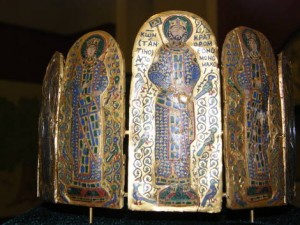What happened to the Byzantine Crown Jewels?
 Listener Shane asked what happened to the Byzantine crown jewels.
Listener Shane asked what happened to the Byzantine crown jewels.
Their story is a sad allegory of the empire itself. They were pawned to Venice in 1343 by the empress Anna of Savoy, who was in the middle of a civil war and desperately needed the money. Her son tried to recover the crown (the replacement diadem was a shoddy job of cut glass and gilded leather), but was hopelessly short of funds. Venice had paid 30,000 ducats- twice what the entire city of Constantinople brought in per year- and there was no way he could raise the amount. On a trip through Europe to drum up support against the Ottomans in 1369, John made the mistake of visiting Venice where he was humiliatingly detained for two years as a debtor. In 1376 he managed to work out a deal for an installment plan where the crown would be returned as a show of good faith after the first payment. Unfortunately, a month later his son overthrew him and Venice refused to send the crown to a usurper. Successive emperors never quite gave up hope- imperial ambassadors officially brought it up in 1390, 1406, 1418, 1423, 1442, and 1448- but Venice preferred to keep it safely locked up in St. Marks as a bargaining tool.
It remained there until 1797 when the Republic of Venice fell to the French. Napoleon thoroughly looted the treasury- leaving behind only the current 283 pieces- and the forgotten crown’s ultimate fate was most likely to be melted down to fund the dictator’s numerous wars.
There is, however, a brighter postscript. Byzantine history is long and there were many crowns. Emperor Michael VII (1074) gave one to the Hungarian King Géza I which is now kept in the Central Hall of the Hungarian Parliament Building. Emperor Constantine IX Monomachus (circa 1042- that’s his at the top) wore another of decorated enameled plates, which can be seen in Budapest. The most prestigious one, however, is undoubtedly the crown of the great Nicephorus Phocas (circa 963), kept today along with his imperial vestments in a monastery on Mt. Athos.